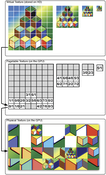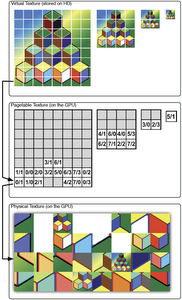Information
- Publication Type: Journal Paper with Conference Talk
- Workgroup(s)/Project(s):
- Date: September 2011
- Journal: Geoinformatics FCE CTU
- Volume: 7
- Location: Czech Technical University in Prague
- Lecturer:
- ISSN: 1802-2669
- Event: XXIIIrd International CIPA Symposium
- Conference date: 12. September 2011
– 16. September 2011
- Keywords: virtual texturing, out-of-core, streaming, point clouds
Abstract
In the last decade the documentation of cultural heritage by means of laser range scanning and photogrammetric techniques has gained ever more importance. The amount of data collected by these means may be huge, and adequate presentation of 3D documented cultural heritage is still a challenge. For small and limited projects consisting of only a few range scans, the software provided with the laser scanner can be used for viewing and presenting the data. Large projects, consisting of hundreds of scan positions as well as projects where more and more data are collected over time, still have to deal with a massive reduction of the 3D data for presentation. Public demonstrations in museums, as for example shown by the Digital Michelangelo project, are already state of the art. The combination of huge point-base models and mesh models with high resolution textures in one viewer, the first type of models resulting from the data of laser range scans and the second type of models resulting from a photogrammetric reconstruction process, is still not available. Currently viewers are mostly limited to show models that are based on only one geometric primitive – either points or polygons – at once.
In the FWF funded START project “The Domitilla Catacomb in Rome. Archaeology, Architecture and Art History of a Late Roman Cemetery” – which is running for 5 years now – 3D point data was collected for the geometrical documentation of the vast gallery system of the Domitilla Catacomb, resulting in point data of some 2 billion (10^9) point samples. Furthermore high quality textured mesh models of the nearly 90 late Roman / early Christian paintings were generated with photogrammetric tools. In close cooperation with the Institute of Computer Graphics and Algorithms of the Vienna University of Technology the point cloud viewer Scanopy was improved for the combined presentation of huge point clouds and high quality textured mesh models in the same viewer. Our viewer is already capable of rendering huge point clouds, so for this a method to manage the vast amount of textures had to be found. Therefore we integrated a virtual texturing algorithm, which allows using the original photographs of the paintings taken on site to be mapped to the mesh models, resulting in a high quality texture for all mesh models. The photographs have a resolution of 11 Megapixels. Due to shortcomings in the programs used in the photogrammetric processing pipeline we scaled down the photographs to a 7.3 Megapixel resolution. Currently 608 of these images are used for texturing 29 mesh models. The work on the mesh models is still ongoing, and when all mesh models will be completed, we will use some 2000 images for texturing about 90 mesh models. These virtually textured models can show the details of each painting in the Domitilla Catacomb. When used in a virtual walkthrough the paintings in the catacomb can be presented to a broad audience under best lighting conditions, even the paintings normally not accessible by the public.
Additional Files and Images
Additional images and videos
Additional files
 paper draft
paper draft:
The Domitilla images are not included due to copyright reasons.
 slides draft
slides draft:
The Domitilla images are not included due to copyright reasons.
Weblinks
No further information available.
BibTeX
@article{mayer_2011_cipa,
title = "Virtual Texturing in the Documentation of Cultural Heritage",
author = "Irmengard Mayer and Claus Scheiblauer and Albert Julian
Mayer",
year = "2011",
abstract = "In the last decade the documentation of cultural heritage by
means of laser range scanning and photogrammetric techniques
has gained ever more importance. The amount of data
collected by these means may be huge, and adequate
presentation of 3D documented cultural heritage is still a
challenge. For small and limited projects consisting of only
a few range scans, the software provided with the laser
scanner can be used for viewing and presenting the data.
Large projects, consisting of hundreds of scan positions as
well as projects where more and more data are collected over
time, still have to deal with a massive reduction of the 3D
data for presentation. Public demonstrations in museums, as
for example shown by the Digital Michelangelo project, are
already state of the art. The combination of huge point-base
models and mesh models with high resolution textures in one
viewer, the first type of models resulting from the data of
laser range scans and the second type of models resulting
from a photogrammetric reconstruction process, is still not
available. Currently viewers are mostly limited to show
models that are based on only one geometric primitive –
either points or polygons – at once. In the FWF funded
START project “The Domitilla Catacomb in Rome.
Archaeology, Architecture and Art History of a Late Roman
Cemetery” – which is running for 5 years now – 3D
point data was collected for the geometrical documentation
of the vast gallery system of the Domitilla Catacomb,
resulting in point data of some 2 billion (10^9) point
samples. Furthermore high quality textured mesh models of
the nearly 90 late Roman / early Christian paintings were
generated with photogrammetric tools. In close cooperation
with the Institute of Computer Graphics and Algorithms of
the Vienna University of Technology the point cloud viewer
Scanopy was improved for the combined presentation of huge
point clouds and high quality textured mesh models in the
same viewer. Our viewer is already capable of rendering huge
point clouds, so for this a method to manage the vast amount
of textures had to be found. Therefore we integrated a
virtual texturing algorithm, which allows using the original
photographs of the paintings taken on site to be mapped to
the mesh models, resulting in a high quality texture for all
mesh models. The photographs have a resolution of 11
Megapixels. Due to shortcomings in the programs used in the
photogrammetric processing pipeline we scaled down the
photographs to a 7.3 Megapixel resolution. Currently 608 of
these images are used for texturing 29 mesh models. The work
on the mesh models is still ongoing, and when all mesh
models will be completed, we will use some 2000 images for
texturing about 90 mesh models. These virtually textured
models can show the details of each painting in the
Domitilla Catacomb. When used in a virtual walkthrough the
paintings in the catacomb can be presented to a broad
audience under best lighting conditions, even the paintings
normally not accessible by the public.",
month = sep,
journal = "Geoinformatics FCE CTU",
volume = "7",
issn = "1802-2669",
keywords = "virtual texturing, out-of-core, streaming, point clouds",
URL = "https://www.cg.tuwien.ac.at/research/publications/2011/mayer_2011_cipa/",
}
 image:
Virtual texturing render pipeline
image:
Virtual texturing render pipeline
 paper draft:
The Domitilla images are not included due to copyright reasons.
paper draft:
The Domitilla images are not included due to copyright reasons.

 paper draft
paper draft